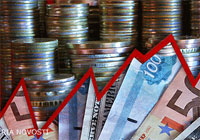Ruble does overtime on downwards slide

(Business New Europe – bne.eu – October 9, 2014) The ruble dropped on October 8 by a further 24 kopecks to the dollar and 29 kopecks to the euro. In order to support the exchange rate, the central bank was estimated by market participants to have sold more than $1.1bn, at least four times raising the upper threshold of the ruble trading corridor.
The central bank raises the corridor by 5 kopecks to the dollar-euro basket for every $350m intervention. This takes total central bank interventions over the last four days to at least $3.15bn, according to analysts, with the trading corridor adjusted upwards at least nine times.
According to analysts, the central bank workforce down tools punctually at 6pm, while currency trading marches on into the evening. As a result, every day this week the ruble has ended the day with a slide, as central bank intervention stops: October 8 falling 14 kopecks in the evening between 6pm and 9pm when currency trading stops.
According to Artem Roshin, a currency dealer at Alba Alliance bank, in comments to business daily Vedomosti, “the market is basically getting ready for upcoming payments [on foreign debt] – clients are ordering [hard currency] and the banks carrying out their orders. If nothing changes – sanctions remain and the price of oil does not recover – this will continue until the end of the year.”
The last time the ruble dropped over 10 kopecks to the dollar-euro basket (used by the central bank to gauge the exchange rate) in the course of a day was 3-4 March when Russia’s parliament gave the president the right to employ armed forces in Ukraine.
“This is not the work of speculators, demand for dollars constantly exceeds supply on the market, the September spike in foreign debt payments has passed, now companies are getting ready for December, and there is no dollar liquidity, so companies are already getting ready now,” the economist of a global investment company toldVedomosti.
VTB Capital analysts also point to the deficit of US dollars – as companies horde dollars in readiness to pay down debt – as driving the ruble’s decline: “Market participants are just chasing the CBR’s offer in the market, since other potential sellers prefer to stay on the sidelines.” According to VTB Capital, the low turnover on the exchange market illustrates this, with daily trading on the exchange market since October not once exceeding $5bn. “The ruble has been falling lately on light trade volumes,” they says.
Besides foreign debt payments that cannot be rolled over because of Western sanctions on Russia, the falling price of oil is adding to the ruble’s downward trajectory. According to Bloomberg, the price of Brent fell below the $90 mark for the first time since June 2012; the price of the Russian Urals mix also dropped below $90.
In addition, the ruble’s crossing the psychologically important 40-ruble rubicon may have prompted people to start buying dollars, say analysts, although this is still believed to be a minor phenomenon.
